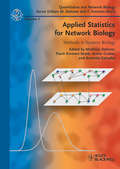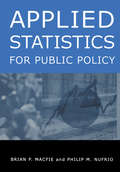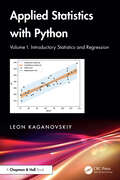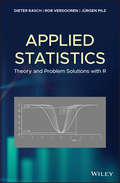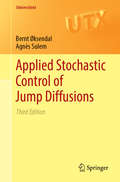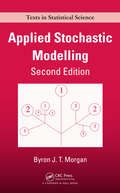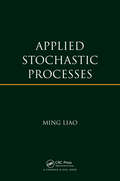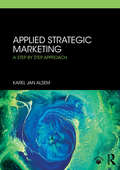- Table View
- List View
Applied Statistics for Business and Management using Microsoft Excel
by Linda Herkenhoff John FogliApplied Business Statistics for Business and Management using Microsoft Excel is the first book to illustrate the capabilities of Microsoft Excel to teach applied statistics effectively. It is a step-by-step exercise-driven guide for students and practitioners who need to master Excel to solve practical statistical problems in industry. If understanding statistics isn't your strongest suit, you are not especially mathematically-inclined, or if you are wary of computers, this is the right book for you. Excel, a widely available computer program for students and managers, is also an effective teaching and learning tool for quantitative analyses in statistics courses. Its powerful computational ability and graphical functions make learning statistics much easier than in years past. However, Applied Business Statistics for Business and Management capitalizes on these improvements by teaching students and practitioners how to apply Excel to statistical techniques necessary in their courses and workplace. Each chapter explains statistical formulas and directs the reader to use Excel commands to solve specific, easy-to-understand business problems. Practice problems are provided at the end of each chapter with their solutions.
Applied Statistics for Economics and Business
by Durmuş ÖzdemirThis textbook introduces readers to practical statisticalissues by presenting them within the context of real-life economics andbusiness situations. It presents the subject in a non-threatening manner, withan emphasis on concise, easily understandable explanations. It has beendesigned to be accessible and student-friendly and, as an added learningfeature, provides all the relevant data required to complete the accompanyingexercises and computing problems, which are presented at the end of eachchapter. It also discusses index numbers and inequality indices in detail,since these are of particular importance to students and commonly omitted intextbooks. Throughout the text it is assumed that the student has noprior knowledge of statistics. It is aimed primarily at business and economicsundergraduates, providing them with the basic statistical skills necessary forfurther study of their subject. However, students of other disciplines willalso find it relevant.
Applied Statistics for Economists
by Margaret LewisThis book is an undergraduate text that introduces students to commonly-used statistical methods in economics. Using examples based on contemporary economic issues and readily-available data, it not only explains the mechanics of the various methods, it also guides students to connect statistical results to detailed economic interpretations. Because the goal is for students to be able to apply the statistical methods presented, online sources for economic data and directions for performing each task in Excel are also included.
Applied Statistics for Network Biology: Methods in Systems Biology (Quantitative and Network Biology (VCH) #5)
by Matthias Dehmer Frank Emmert-Streib Armindo Salvador Armin GraberThe book introduces to the reader a number of cutting edge statistical methods which can e used for the analysis of genomic, proteomic and metabolomic data sets. In particular in the field of systems biology, researchers are trying to analyze as many data as possible in a given biological system (such as a cell or an organ). The appropriate statistical evaluation of these large scale data is critical for the correct interpretation and different experimental approaches require different approaches for the statistical analysis of these data. This book is written by biostatisticians and mathematicians but aimed as a valuable guide for the experimental researcher as well computational biologists who often lack an appropriate background in statistical analysis.
Applied Statistics for Public Policy
by Brian P. Macfie Philip M. NufrioThis practical text provides students with the statistical tools needed to analyze data, and shows how statistics can be used as a tool in making informed, intelligent policy decisions. The authors' approach helps students learn what statistical measures mean and focus on interpreting results, as opposed to memorizing and applying dozens of statistical formulae. The book includes more than 500 end-of-chapter problems, solvable with the easy-to-use Excel spreadsheet application developed by the authors. This template allows students to enter numbers into the appropriate sheet, sit back, and analyze the data. This comprehensive, hands-on textbook requires only a background in high school algebra and has been thoroughly classroom-tested in both undergraduate and graduate level courses. No prior expertise with Excel is required. A disk with the Excel template and the data sets is included with the book, and solutions to the end-of-chapter problems will be provided on the M.E. Sharpe website.
Applied Statistics for Public and Nonprofit Administration
by Kenneth J. Meier Jeffrey L. Brudney John BohteAs the first book ever published for public administration statistics courses, APPLIED STATISTICS FOR PUBLIC AND NONPROFIT ADMINISTRATION makes a difficult subject accessible to students and practitioners of public administration and to non-profit studies who have little background in statistics or research methods. Steeped in experience and practice, this landmark text remains the first and best in research methods and statistics for students and practitioners in public-and nonprofit-administration. All statistical techniques used by public administration professionals are covered, and all examples in the text relate to public administration and the nonprofit sector. Avoiding jargon and formula, this text uses a step-by-step approach that facilitates student learning.
Applied Statistics for Social and Management Sciences
by Abdul Quader MiahThis book addresses the application of statistical techniques and methods across a wide range of disciplines. While its main focus is on the application of statistical methods, theoretical aspects are also provided as fundamental background information. It offers a systematic interpretation of results often discovered in general descriptions of methods and techniques such as linear and non-linear regression. SPSS is also used in all the application aspects. The presentation of data in the form of tables and graphs throughout the book not only guides users, but also explains the statistical application and assists readers in interpreting important features. The analysis of statistical data is presented consistently throughout the text. Academic researchers, practitioners and other users who work with statistical data will benefit from reading Applied Statistics for Social and Management Sciences.
Applied Statistics for the Social and Health Sciences
by Rachel A. GordonApplied Statistics for the Social and Health Sciences provides graduate students in the social and health sciences with the basic skills that they need to estimate, interpret, present, and publish statistical models using contemporary standards. The book targets the social and health science branches such as human development, public health, sociology, psychology, education, and social work in which students bring a wide range of mathematical skills and have a wide range of methodological affinities. For these students, a successful course in statistics will not only offer statistical content but will also help them develop an appreciation for how statistical techniques might answer some of the research questions of interest to them. This book is for use in a two-semester graduate course sequence covering basic univariate and bivariate statistics and regression models for nominal and ordinal outcomes, in addition to covering ordinary least squares regression. Key features of the book include: interweaving the teaching of statistical concepts with examples developed for the course from publicly-available social science data or drawn from the literature thorough integration of teaching statistical theory with teaching data processing and analysis teaching of both SAS and Stata "side-by-side" and use of chapter exercises in which students practice programming and interpretation on the same data set and course exercises in which students can choose their own research questions and data set. This book is for a two-semester course. For a one-semester course, see http://www.routledge.com/9780415991544/
Applied Statistics for the Social and Health Sciences
by Rachel A. GordonCovering basic univariate and bivariate statistics and regression models for nominal, ordinal, and interval outcomes, Applied Statistics for the Social and Health Sciences provides graduate students in the social and health sciences with fundamental skills to estimate, interpret, and publish quantitative research using contemporary standards.Reflecting the growing importance of "Big Data" in the social and health sciences, this thoroughly revised and streamlined new edition covers best practice in the use of statistics in social and health sciences, draws upon new literatures and empirical examples, and highlights the importance of statistical programming, including coding, reproducibility, transparency, and open science.Key features of the book include: interweaving the teaching of statistical concepts with examples from publicly available social and health science data and literature excerpts; thoroughly integrating the teaching of statistical theory with the teaching of data access, processing, and analysis in Stata; recognizing debates and critiques of the origins and uses of quantitative methods.
Applied Statistics in Biomedicine and Clinical Trials Design: Selected Papers from 2013 ICSA/ISBS Joint Statistical Meetings (ICSA Book Series in Statistics)
by Zhen Chen Aiyi Liu Yongming Qu Larry Tang Naitee Ting Yi TsongThis volume is a unique combination of papers that cover critical topics in biostatistics from academic, government, and industry perspectives. The 6 sections cover Bayesian methods in biomedical research; Diagnostic medicine and classification; Innovative Clinical Trials Design; Modelling and Data Analysis; Personalized Medicine; and Statistical Genomics. The real world applications are in clinical trials, diagnostic medicine and genetics. The peer-reviewed contributions were solicited and selected from some 400 presentations at the annual meeting of the International Chinese Statistical Association (ICSA), held with the International Society for Biopharmaceutical Statistics (ISBS). The conference was held in Bethesda in June 2013, and the material has been subsequently edited and expanded to cover the most recent developments.
Applied Statistics in Business and Economics
by David P. Doane Lori E. SewardApplied Statistics in Business and Economics, 7th edition, provides real meaning to the use of statistics in the real world by using real business situations and real data while appealing to students who want to know the why rather than just the how. The text emphasizes thinking about data, choosing appropriate analytic tools, using computers effectively, and recognizing the limitations of statistics. It motivates student learning through applied current exercises and cases that provide real-world relevance and includes analytics in action, careers, and applications of big data, Artificial Intelligence, and machine learning (including ethical issues). The Doane and Seward authors work as a team, integrating the digital and eBook assets seamlessly. In recognition of a growing interest in analytics training beyond Excel, the textbook now provides an optional introduction to R with illustrations of topics in each chapter. Support for R is further enhanced with Learning Stats modules, tables of R functions, and R-compatible Excel data sets.
Applied Statistics in Social Sciences
by Emilio Gómez-Déniz Enrique Calderín-OjedaThis work is a detailed description of different discrete and continuous univariate and multivariate distributions with applications in economics and different financial problems and other scenarios in which these recently developed statistical models have been applied in recent years, including actuarial statistics (with emphasis on credibility theory, ruin theory, calculation of insurance premiums, etc.), stochastic frontier analysis (estimation of technical efficiency), duration models (intraday rate of trading), population geography, income and wealth distribution, physical economy, tourism and sports, among others. Each distribution is dealt with in a separate chapter along with descriptions of all possible applications. The authors also provide a detailed analysis of the proposed probabilistic families, discussing their relationship with existing models, statistical properties, analyzing their strengths and weaknesses, similarities and differences, different estimation methods along with comments on possible applications and extensions. Simulation methods are given for most of the models presented. Many of the probabilistic models shown along with their applications in the fields indicated are a result of numerous research articles published by the authors although others are also provided, mainly based on classical formulations, which have been the starting point of more general models. This volume contains an extensive updated bibliography selected from magazines and books on statistics, mathematics, economics, actuarial sciences and computer science. This book is an essential manual for researchers, professionals, professionals and, in general, for graduate students in computer science, engineering, bioinformatics, statistics and mathematics, since the concise writing style makes the book accessible to a wide audience.
Applied Statistics with Python: Volume I: Introductory Statistics and Regression
by Leon KaganovskiyApplied Statistics with Python: Volume I: Introductory Statistics and Regression concentrates on applied and computational aspects of statistics, focusing on conceptual understanding and Python-based calculations. Based on years of experience teaching introductory and intermediate Statistics courses at Touro University and Brooklyn College, this book compiles multiple aspects of applied statistics, teaching the reader useful skills in statistics and computational science with a focus on conceptual understanding. This book does not require previous experience with statistics and Python, explaining the basic concepts before developing them into more advanced methods from scratch. Applied Statistics with Python is intended for undergraduate students in business, economics, biology, social sciences, and natural science, while also being useful as a supplementary text for more advanced students.Key Features: Concentrates on more introductory topics such as descriptive statistics, probability, probability distributions, proportion and means hypothesis testing, as well as one-variable regression The book’s computational (Python) approach allows us to study Statistics much more effectively. It removes the tedium of hand/calculator computations and enables one to study more advanced topics Standardized sklearn Python package gives efficient access to machine learning topics Randomized homework as well as exams are provided in the author’s course shell on My Open Math web portal (free)
Applied Statistics with SPSS
by Dr Eelko K HuizinghAccessibly written and easy to use, Applied Statistics Using SPSS is an all-in-one self-study guide to SPSS and do-it-yourself guide to statistics. Based around the needs of undergraduate students embarking on their own research project, the text's self-help style is designed to boost the skills and confidence of those that will need to use SPSS in the course of doing their research project. The book is pedagogically well developed and contains many screen dumps and exercises, glossary terms and worked examples. Divided into two parts, Applied Statistics Using SPSS covers : 1. A self-study guide for learning how to use SPSS. 2. A reference guide for selecting the appropriate statistical technique and a stepwise do-it-yourself guide for analysing data and interpreting the results. 3. Readers of the book can download the SPSS data file that is used for most of the examples throughout the book here. Geared explicitly for undergraduate needs, this is an easy to follow SPSS book that should provide a step-by-step guide to research design and data analysis using SPSS.
Applied Statistics: Business and Management Research
by Andrew R. TimmingWritten for the non-mathematician and free of unexplained technical jargon, Applied Statistics: Business and Management Research provides a user-friendly introduction to the field of applied statistics and data analysis. Featuring step-by-step explanations of how to carry out successful quantitative research, and supported by examples from IBM® SPSS® Statistics, this textbook is an essential resource for students and researchers of business and management. A range of online resources for both students and lecturers, including a teaching guide, PowerPoint slides and datasets, are available via the companion website. Andrew R. Timming is Professor of Human Resource Management and Deputy Dean Research & Innovation in the School of Management at RMIT University, Australia.
Applied Statistics: Business and Management Research
by Andrew R. TimmingWritten for the non-mathematician and free of unexplained technical jargon, Applied Statistics: Business and Management Research provides a user-friendly introduction to the field of applied statistics and data analysis. Featuring step-by-step explanations of how to carry out successful quantitative research, and supported by examples from IBM® SPSS® Statistics, this textbook is an essential resource for students and researchers of business and management. A range of online resources for both students and lecturers, including a teaching guide, PowerPoint slides and datasets, are available via the companion website. Andrew R. Timming is Professor of Human Resource Management and Deputy Dean Research & Innovation in the School of Management at RMIT University, Australia.
Applied Statistics: From Bivariate Through Multivariate Techniques
by Rebecca M. WarnerRebecca M. Warner's Applied Statistics: From Bivariate Through Multivariate Techniques, Second Edition provides a clear introduction to widely used topics in bivariate and multivariate statistics, including multiple regression, discriminant analysis, MANOVA, factor analysis, and binary logistic regression. The approach is applied and does not require formal mathematics; equations are accompanied by verbal explanations. Students are asked to think about the meaning of equations. Each chapter presents a complete empirical research example to illustrate the application of a specific method. Although SPSS examples are used throughout the book, the conceptual material will be helpful for users of different programs. Each chapter has a glossary and comprehension questions.
Applied Statistics: From Bivariate Through Multivariate Techniques (2nd Edition)
by Rebecca M. WarnerApplied Statistics: From Bivariate Through Multivariate Techniques, Second Edition provides a clear introduction to widely used topics in bivariate and multivariate statistics, including multiple regression, discriminant analysis, MANOVA, factor analysis, and binary logistic regression. The approach is applied and does not require formal mathematics; equations are accompanied by verbal explanations. Students are asked to think about the meaning of equations. Each chapter presents a complete empirical research example to illustrate the application of a specific method. Although SPSS examples are used throughout the book, the conceptual material will be helpful for users of different programs. Each chapter has a glossary and comprehension questions.
Applied Statistics: Handbook of GENSTAT Analysis
by E. J. Snell H. SimpsonGENSTAT is a general purpose statistical computing system with a flexible command language operating on a variety of data structures. It may be used on a number of computer ranges, either interactively for exploratory data analysis, or in batch mode for standard data analysis.The great flexibility of GENSTAT is demonstrated in this handbook by analysing the wide range of examples discussed in Applied Statistics - Principles and Examples (Cox and Snell, 1981). GENSTAT programs are listed for each of the examples. Most of the data sets are small but often it is these seemingly small problems which involve the most tricky statistical and computational procedures. This handbook is self-contained although for a full description of the analysis and interpretation it should be used in parallel with Applied Statistics - Principles and Examples.
Applied Statistics: Theory and Problem Solutions with R
by Dieter Rasch Jürgen Pilz Rob VerdoorenInstructs readers on how to use methods of statistics and experimental design with R software Applied statistics covers both the theory and the application of modern statistical and mathematical modelling techniques to applied problems in industry, public services, commerce, and research. It proceeds from a strong theoretical background, but it is practically oriented to develop one's ability to tackle new and non-standard problems confidently. Taking a practical approach to applied statistics, this user-friendly guide teaches readers how to use methods of statistics and experimental design without going deep into the theory. Applied Statistics: Theory and Problem Solutions with R includes chapters that cover R package sampling procedures, analysis of variance, point estimation, and more. It follows on the heels of Rasch and Schott's Mathematical Statistics via that book's theoretical background—taking the lessons learned from there to another level with this book’s addition of instructions on how to employ the methods using R. But there are two important chapters not mentioned in the theoretical back ground as Generalised Linear Models and Spatial Statistics. Offers a practical over theoretical approach to the subject of applied statistics Provides a pre-experimental as well as post-experimental approach to applied statistics Features classroom tested material Applicable to a wide range of people working in experimental design and all empirical sciences Includes 300 different procedures with R and examples with R-programs for the analysis and for determining minimal experimental sizes Applied Statistics: Theory and Problem Solutions with R will appeal to experimenters, statisticians, mathematicians, and all scientists using statistical procedures in the natural sciences, medicine, and psychology amongst others.
Applied Stochastic Control of Jump Diffusions (Universitext)
by Bernt Øksendal Agnès SulemHere is a rigorous introduction to the most important and useful solution methods of various types of stochastic control problems for jump diffusions and its applications. Discussion includes the dynamic programming method and the maximum principle method, and their relationship. The text emphasises real-world applications, primarily in finance. Results are illustrated by examples, with end-of-chapter exercises including complete solutions. The 2nd edition adds a chapter on optimal control of stochastic partial differential equations driven by Lévy processes, and a new section on optimal stopping with delayed information. Basic knowledge of stochastic analysis, measure theory and partial differential equations is assumed.
Applied Stochastic Differential Equations (Institute of Mathematical Statistics Textbooks #10)
by Simo Särkkä Arno SolinStochastic differential equations are differential equations whose solutions are stochastic processes. They exhibit appealing mathematical properties that are useful in modeling uncertainties and noisy phenomena in many disciplines. This book is motivated by applications of stochastic differential equations in target tracking and medical technology and, in particular, their use in methodologies such as filtering, smoothing, parameter estimation, and machine learning. It builds an intuitive hands-on understanding of what stochastic differential equations are all about, but also covers the essentials of Itô calculus, the central theorems in the field, and such approximation schemes as stochastic Runge–Kutta. Greater emphasis is given to solution methods than to analysis of theoretical properties of the equations. The book's practical approach assumes only prior understanding of ordinary differential equations. The numerous worked examples and end-of-chapter exercises include application-driven derivations and computational assignments. MATLAB/Octave source code is available for download, promoting hands-on work with the methods.
Applied Stochastic Modelling (Chapman & Hall/CRC Texts in Statistical Science)
by Byron J.T. MorganHighlighting modern computational methods, Applied Stochastic Modelling, Second Edition provides students with the practical experience of scientific computing in applied statistics through a range of interesting real-world applications. It also successfully revises standard probability and statistical theory. Along with an updated bibliography and
Applied Stochastic Processes
by Ming LiaoApplied Stochastic Processes presents a concise, graduate-level treatment of the subject, emphasizing applications and practical computation. It also establishes the complete mathematical theory in an accessible way. After reviewing basic probability, the text covers Poisson processes, renewal processes, discrete- and continuous-time Markov chains,
Applied Strategic Marketing: A Step by Step Approach
by Karel Jan AlsemThis book, originally published in Dutch, provides a uniquely practical approach to strategic marketing planning. Combining a comprehensive overview of theory with practice, each chapter takes the reader step by step through the strategic marketing process. Beginning with identifying the value proposition, it moves on to the situational analysis that underpins the corporate strategy, and finally details the overall implementation and creation of a customer and brand values. Applied Strategic Marketing equips the reader with the necessary tools and techniques to develop and deliver a thorough and effective marketing strategy. With a broad range of international case studies that bring the theory to life, this well-renowned and updated translation is vital reading for undergraduate and postgraduate students of marketing management and strategic marketing. It should also be of interest to marketing practitioners who want a clear overview to aid them in the planning process.



